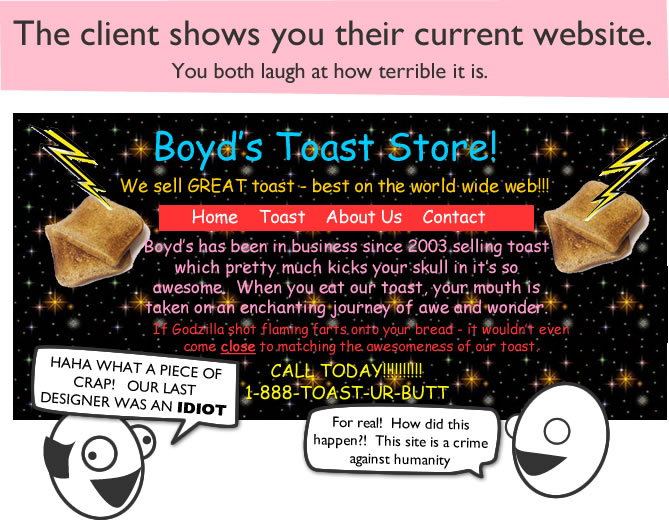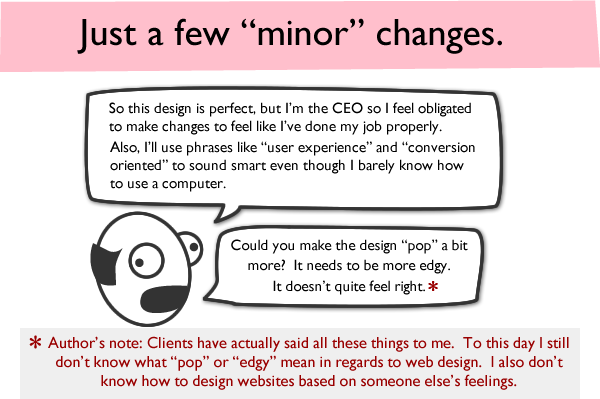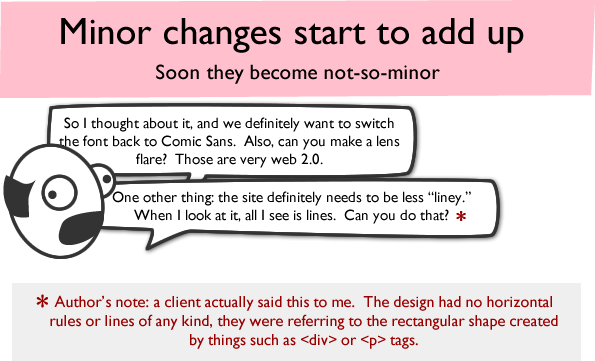Project Management and Website Design
As a digital agency, it’s important to consider how we can not only support our clients and their business objectives, but also minimize project pitfalls and create clear pathways to success during the website design process.
Most of us working in the tech industry have stumbled across Clients from Hell or similar sites bashing seemingly challenging clients. Browsing does provides a certain level of satisfying schadenfreude (and guilt), but instead of placing the onus completely on one party, we (on both sides of the work) should take a hard look at what we can do to minimize the likelihood of common web design project pitfalls.
Let’s go through the steps of Mathew Inman’s HOW A WEB DESIGN GOES STRAIGHT TO HELL.

Step One
This is a great start. As a project manager, one of my favorite parts of the job is tapping into that innate excitement of a new project. Enthusiasm goes so far, internally and from a client standpoint, in getting through the work smoothly.
But really, what does “great” mean? Instead of just assuming the project is going to be seen as a success by all, define success early and check in regulargly with the client to ensure you're exceeding expectations throughout the process.
As the client
Decide the primary reason you want a new website and communicate that to your web designer.
As the project manager
Define acceptable and measurable goals that align with the client’s needs, such as “monthly pageview increase of 10%,” “increased number of quote request form submissions,” and so on. Achieve buyoff from the client on exactly what a successful project means.
Step Two

It’s a great idea to take a look at the baseline. As tempting as it is to simply rip into the existing design, there is a lot of valuable information you can glean and important groundwork to lay at this stage. There must have been reasons the site above looks like a Myspace template designed by a 5-year-old on an ice-cream induced frenzy. Just like seemingly inelegant code can be written by a normally very competent programmer, time constraints, indecision, and last-minute changes can have negative additive effects on the design as a whole.
As the client
Determine what about the existing design you like. Is there anything at all? Pick specific, concrete aspects you dislike and would not like repeated.
As the project manager
Make sure you get input from all important stakeholders. Is there a hidden VP of Marketing that is too busy to give instruction at this stage? Red flag. Everyone that has a say in the end result should be included now.
Step Three

Yes. It’s nice to have the freedom to go all out and create something with full artistic license and creative control. But, it should never be a big reveal with a “TA-DA!”
There shouldn’t be any surprises. Web design is an iterative process and the client should be involved at each key step. The final look and feel must be decided upon, together.
As the client
Ensure that you are being clear with what you want and expect to see before we get here. You know how it helps your barber/hair stylist if you bring pictures and know the style you want? Same with web design. It’s so helpful when you come with examples of websites whose look you appreciate and aesthetics that inspire your brand. Try starting a Pinterest board!
Follow Eva's board Design on Pinterest.
As the project manager
Do not just send off the web design mock. Set up a call or screenshare, and before plopping up the design on the screen, explain what overarching goal the page is achieving. Once you pull up the mock, explain the benefit and purpose of each design element, tying it back to the larger goal each time.
Step Four

Feedback is a wonderful thing. Receiving feedback means that you have engaged partners in the project that care, and believe in you to take their ideas and create something beautiful.
However, there is feedback, and then there is useful, actionable feedback.
As the client
Recall the goals that were agreed upon at the outset. How does the design meet or not meet these needs? Call those forward. If there’s just a general feeling of “not being wowed,” search your feelings and determine what the causes of that could be, such as a specific color combination or type treatment that doesn’t align with your brand.
As the project manager
It’s our job to read between the lines and determine exactly what the client means, and package that into concrete action points for the design team. It can be hard to probe, but it’s crucial to really get down what exactly needs to change and why. Ensure you receive enough useful feedback so that the next design will continue to serve the primary goals of the new site, and that the new design changes do not put those in jeopardy. After all, you serve the project, and your success is now defined by hitting those original goals set forth at the outset. The client is depending on you to help them remember the primary project goals and sidestep details that don’t ultimately get the website closer to reaching those said goals.
Step Five

Sorry, no. We’re not using Comic Sans.
Step Six

Go back and see STEP TWO. This scenario can actually be completely avoided if you had all stakeholders involved from the start. It is important to get all of the decision makers together to decide on the aesthetic together, at the outset.
As the client
Ensure you have the input and buyoff of everyone that needs to be involved, early.
As the project manager
Always go back to the original goals of the website. Is the web design meeting that? How? Each design element should be working together toward reaching those goals, and it is your job to determine if the new feedback will help serve those goals. If they will not, carefully explain why and how they would sabotage or dilute the project’s success.
Step Seven

Yes, we can totally include Miffles, as long as Miffles’ stream of consciousness is going to help you get those form submission numbers up.
As the client
One of the designer’s personal goals is to create great work that he/she is proud of. Your trust in their design eye is important (if you’re signing on for web design, make sure that you like the agency or designer’s portfolio beforehand). You should be able to lean on them for design advice; don’t be shy about asking them to explain the thought behind their work—they will be glad to! Instead of providing what you’d like to see in a closed-form suggestion, ask what their opinion of your idea is. If something like this absolutely has to be on the site, it should have been a primary goal decided upon at the start of the project, so that the rest of the design could support it.
As the project manager
There is probably a way to include Miffles on the site without entirely destroying the integrity of the complete design. Find what about having Miffles is important to the client, and work to implement that in a pleasing way. In addition, consider running an A/B test of this new feature to determine how useful/harmful it would be to accomplishing the site’s original goals. This can be a powerful determinant in whether or not Miffles makes the cut.
Step Eight

So sad. The good news is, this scenario can be avoided as long as both sides are communicating effectively throughout the process.
Step Nine

And now you see what happened to the original site design/ designer in this series.
Remember, to avoid these dramatized pitfalls, first ensure that the primary goals of the site have both internal and client buy-off at the outset of the project. These goals should be concrete, with success defined in specific measurements. Then, receive input from all stakeholders, and include the client throughout the iterative design process. There shouldn’t be surprises at any phase! If there’s a question about whether a new feature will promote the site goals, run some user tests (quick and dirty with unsuspecting coworkers or through testing websites like Usability Hub) and do your research with the client's goals in mind. Once your beautiful, functional, and goal-driven site is launched, check back in after a few months to make sure you’re on track to hitting those goals.
All in all, the web design process is one that is exciting and should be rewarding for all. It’s really important to carry the positive momentum from the early stages of the project forward, and keeping that enthusiasm alive is easy as long as the foundation of what needs to be created and for what purpose is clearly laid out. As web designers or project managers, it’s up to us to make sure the final product is beautiful, functional, and meets all the requirements and goals that the client paid us to achieve.
Interested in learning more about the web design process with Adpearance? Check out our online portfolio or give us a call — we'd love to chat.
About the Author
Adpearance is the digital marketing company obsessed with generating quality leads. Our solutions combine cutting-edge technology, premium tracking, and an expert team to transform business results.
Follow Us
Subscribe to our newsletter
Come on... You know you want to.
Related Posts
Subscribe to our newsletter
Get monthly newsletters with timely blogs and occasionally announcements for resources including in-depth reports, data-driven insights, and webinars.